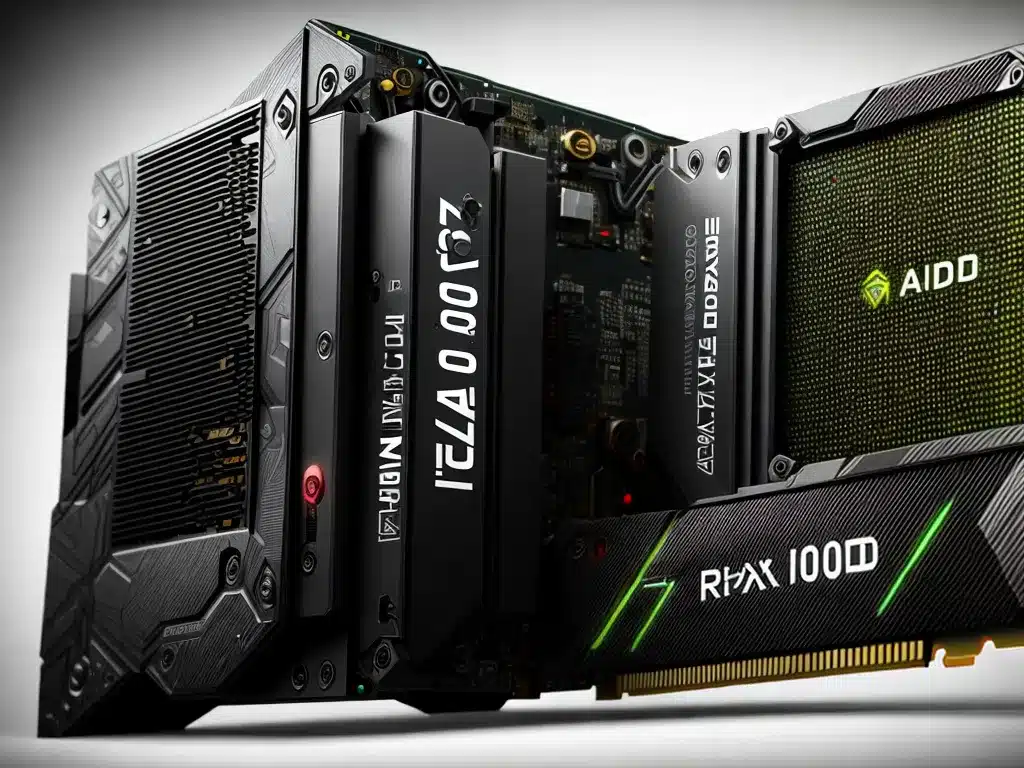
AMD is set to launch its next-generation Radeon RX 7000 series graphics cards later this year. These new GPUs will be based on AMD’s RDNA 3 architecture, which the company claims will deliver over 50% better performance per watt compared to RDNA 2. Nvidia currently dominates the high-end graphics card market with its Ampere architecture. But AMD hopes to challenge Nvidia’s supremacy with RDNA 3. In this article, I take an in-depth look at how the upcoming Radeon RX 7000 series based on RDNA 3 is expected to compete against Nvidia’s current and upcoming GPU offerings.
RDNA 3 Architecture Overview
The RDNA 3 architecture will be manufactured on a 5nm process and feature a chiplet design. AMD will combine multiple small dies together to create large monolithic GPUs. This modular approach allows AMD to mix and match chiplets to target different performance and price points.
Some of the key advances of RDNA 3 over RDNA 2 include:
- Improved performance per watt by over 50%
- Enhanced ray tracing capabilities
- Faster infinity cache
- Higher clock speeds
- Refined compute units
RDNA 3 will also introduce advanced chiplet interconnect technology to combine chiplets seamlessly into a single GPU. Overall, these architectural improvements should result in significant performance gains over RDNA 2.
How RDNA 3 Compares to Ampere
Nvidia’s current flagship graphics cards like the RTX 3080 and RTX 3090 are based on the Ampere architecture. RDNA 3 needs to beat Ampere to claim the performance crown.
Early leaks indicate RDNA 3 GPUs with up to 24GB of GDDR6 memory and GPU clocks over 2.5GHz. This should allow the Radeon RX 7900 XT to surpass the RTX 3090 in traditional rasterization performance.
Ray tracing is one area where Ampere still dominates over RDNA 2. But AMD has confirmed RDNA 3 will bring improved ray tracing performance. With optimized ray tracing cores and faster infinity cache, RDNA 3 could match or even beat Ampere in ray tracing workloads.
Power efficiency is another key metric where RDNA 3 is expected to beat Ampere by a significant margin. AMD says RDNA 3 will deliver over 50% better perf per watt compared to RDNA 2. In contrast, Ampere delivered only about 1.5x better efficiency over Turing. This large efficiency advantage could give RDNA 3 the upper hand in performance per watt.
How RDNA 3 Will Compete with Next-Gen Lovelace
Nvidia is also readying its own next-generation graphics cards based on the Lovelace architecture. Lovelace GPUs will be manufactured on TSMC’s 5nm process and likely arrive in 2023.
RDNA 3 will compete directly against Lovelace at the high-end. Both architectures are expected to support advanced features like chiplet design, MCM GPUs, PCIe 5.0, and fast GDDR6 memory.
Ray tracing and AI-accelerating RT cores will be a key battleground between RDNA 3 and Lovelace. Nvidia is likely to claim ray tracing supremacy with Lovelace. But AMD will try to minimize any ray tracing performance gap with RDNA 3.
Power efficiency will be another close matchup between the two architectures. Both RDNA 3 and Lovelace are built on TSMC’s 5nm process so should deliver excellent efficiency. But early rumors indicate Lovelace may have a slight efficiency advantage over RDNA 3.
Overall, the competition between RDNA 3 and Lovelace will be much closer compared to RDNA 2 vs Ampere. AMD seems poised to fight Nvidia on more equal footing with its RDNA 3 GPUs. But Nvidia will retain its advantages in ray tracing and software ecosystem with Lovelace.
RDNA 3 Mobile GPUs Will Take on RTX 40 Series
The battle between RDNA 3 and Lovelace will also play out in the mobile GPU segment. AMD’s RDNA 3 and Nvidia’s RTX 40 series mobile chips will power gaming laptops in 2023.
AMD is expected to launch RDNA 3 mobile GPUs like the Radeon RX 7800M and RX 7700M to compete with flagships like the RTX 4080 and RTX 4070. Both will leverage advancing power efficiency to enable slim and light gaming laptops.
Nvidia may retain a lead in mobile ray tracing performance. But AMD will leverage RDNA 3 architectural improvements to boost traditional rasterization performance in laptops. RDNA 3 could help AMD achieve performance leadership in mobile gaming.
Conclusion
RDNA 3 represents AMD’s best chance yet to disrupt Nvidia’s dominance in the GPU market. Leveraging TSMC’s advanced 5nm process and chiplet technology, RDNA 3 is poised to beat Ampere and match up well against next-gen Lovelace. Improved performance, efficiency, and ray tracing capabilities will make Radeon RX 7000 series compelling high-end graphics card offerings when they launch later this year. While Nvidia is sure to counter with its own Lovelace architecture, RDNA 3 looks set to make the GPU battle extremely close between the two rivals. For consumers, this elevated competition should bring faster innovation and more options when purchasing high-end graphics cards in 2022 and 2023.












